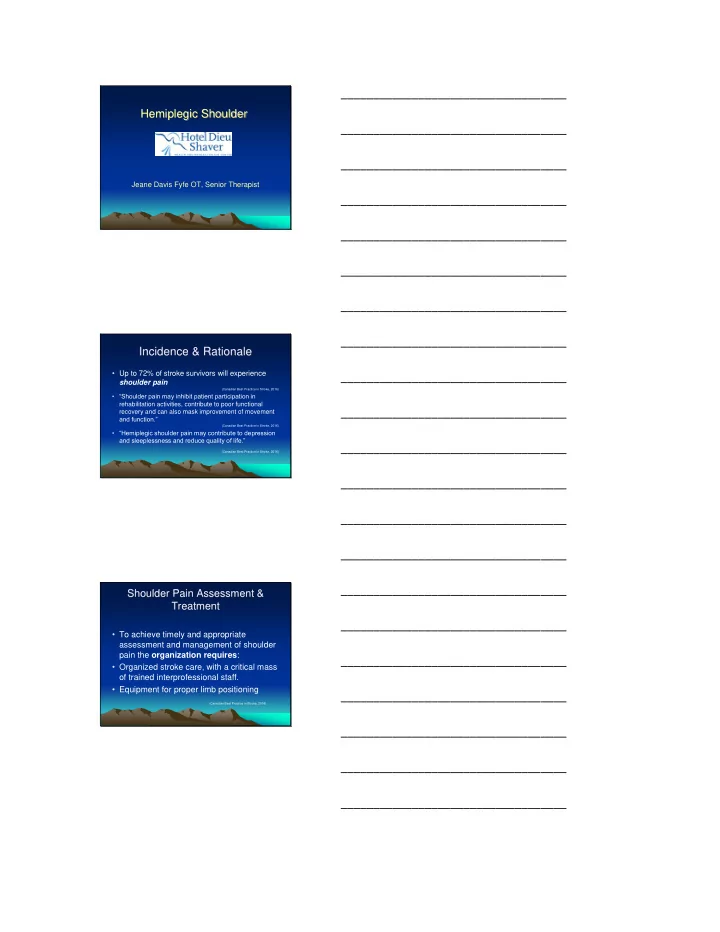

___________________________________ Hemiplegic Shoulder ___________________________________ ___________________________________ Jeane Davis Fyfe OT, Senior Therapist ___________________________________ ___________________________________ ___________________________________ ___________________________________ ___________________________________ Incidence & Rationale • Up to 72% of stroke survivors will experience ___________________________________ shoulder pain (Canadian Best Practice in Stroke, 2016) • “Shoulder pain may inhibit patient participation in rehabilitation activities, contribute to poor functional ___________________________________ recovery and can also mask improvement of movement and function.” (Canadian Best Practice in Stroke, 2016) • “Hemiplegic shoulder pain may contribute to depression and sleeplessness and reduce quality of life.” ___________________________________ (Canadian Best Practice in Stroke, 2016) ___________________________________ ___________________________________ ___________________________________ ___________________________________ Shoulder Pain Assessment & Treatment ___________________________________ • To achieve timely and appropriate assessment and management of shoulder pain the organization requires : ___________________________________ • Organized stroke care, with a critical mass of trained interprofessional staff. • Equipment for proper limb positioning ___________________________________ (Canadian Best Practice in Stroke, 2016) ___________________________________ ___________________________________ ___________________________________
___________________________________ Shoulder Pain Assessment & Treatment ___________________________________ • To achieve timely and appropriate assessment and management of shoulder pain the organization should provide : ___________________________________ • Initial assessment of ROM • Timely access to specialized, interprofessional stroke rehabilitation ___________________________________ services (Canadian Best Practice in Stroke, 2016) ___________________________________ ___________________________________ ___________________________________ ___________________________________ Objectives ___________________________________ • Why is the shoulder at risk? • Presentations of the Hemiplegic Arm ___________________________________ • Review of positioning ___________________________________ • Review of handling techniques ___________________________________ ___________________________________ ___________________________________ ___________________________________ Anatomy: Glenohumeral Joint ___________________________________ ___________________________________ ___________________________________ ___________________________________ ___________________________________ ___________________________________
___________________________________ Glenohumeral Joint • Ball and socket joint ___________________________________ • Stability vs. Mobility ___________________________________ • Only 1/3 of the humeral head is in contact with glenoid fossa during arm movement ___________________________________ ___________________________________ ___________________________________ ___________________________________ ___________________________________ Shoulder Movement • From 0-30 degrees: ___________________________________ – Setting of scapula – Primarily glenohumeral movement • From 30-150 degrees: ___________________________________ – Scapulohumeral rhythm (2:1 GH:scapula) – External rotation and depression of humeral head to clear acromial arch • Beyond 150 degrees: ___________________________________ – Thoracic extension to complete elevation ___________________________________ ___________________________________ ___________________________________ ___________________________________ Low Tone Shoulder ___________________________________ vs. High Tone Shoulder ___________________________________ ___________________________________ ___________________________________ ___________________________________ ___________________________________
___________________________________ Low Tone Shoulder • Most commonly seen early in stroke recovery ___________________________________ • Flaccid or low tone muscles at shoulder and trunk lead to altered alignment of scapula and humerus • Motor pathways have been damaged that innervate the ___________________________________ upper limb muscles • Sensory impairment very common • Very susceptible to structural damage (muscles, ___________________________________ tendons, ligaments) ___________________________________ ___________________________________ ___________________________________ ___________________________________ Shoulder Subluxation ___________________________________ Consequences: • Structural changes can mask motor recovery ___________________________________ • Shoulder pain can influence a survivor’s participation ___________________________________ ___________________________________ ___________________________________ ___________________________________ ___________________________________ ___________________________________ ___________________________________ ___________________________________ ___________________________________ ___________________________________ ___________________________________
___________________________________ High Tone Upper Limb • Usually occurs later post stroke ___________________________________ • Change in the central nervous system resulting increased tone ___________________________________ • Tone can be influenced by: • Positioning • Physical exertion (i.e.transfers) • Pain ___________________________________ ___________________________________ ___________________________________ ___________________________________ ___________________________________ High Tone Upper Limb • “Flexor Pattern” ___________________________________ – Scapular retraction – Shoulder internal rotation and adduction – Elbow flexion ___________________________________ – Forearm pronation – Wrist and finger flexion ___________________________________ ___________________________________ ___________________________________ ___________________________________ ___________________________________ High Tone Upper Limb At risk for: ___________________________________ • Contracture formation • Skin integrity ___________________________________ • Shoulder pain ___________________________________ ___________________________________ ___________________________________ ___________________________________
___________________________________ Positioning 6.4 ii) Joint protection strategies should be ___________________________________ instituted to minimize joint trauma d) staff should position patients, whether ___________________________________ lying or sitting, to minimize the risk of complications such as shoulder pain (Canadian Best Practice in Stroke, 2010) ___________________________________ ___________________________________ ___________________________________ ___________________________________ ___________________________________ Positioning of the Upper Limb ___________________________________ • Make sure the pelvis and trunk are aligned. • Position shoulder in slight flexion, abduction, and external rotation; forearm in pronation and hand in open weightbearing ___________________________________ position (palm down). ___________________________________ ___________________________________ ___________________________________ ___________________________________ ___________________________________ Positioning of Low Tone Upper Limb Benefits: ___________________________________ • Support the shoulder joint to minimize subluxation • Minimize edema to the wrist and hand with ___________________________________ elevation • Promote sensory awareness ___________________________________ ___________________________________ ___________________________________ ___________________________________
___________________________________ Positioning of High Tone Upper Limb ___________________________________ Benefits: • Maintaining muscle and joint length ___________________________________ ___________________________________ ___________________________________ ___________________________________ ___________________________________ ___________________________________ Positioning & Supportive Devices Positioning devices (static postures): ___________________________________ • Use pillows, lap trays, troughs, towels, airsplints, splints Supportive devices (during dynamic activities only – removed when sitting or lying down): ___________________________________ • Use slings, pockets, waistband of pants, splinting cuff ___________________________________ ___________________________________ ___________________________________ ___________________________________ ___________________________________ Positioning of the Upper Limb ___________________________________ • Make sure the pelvis and trunk are aligned. • Position shoulder in slight flexion, abduction, and external rotation; forearm in pronation and hand in open weightbearing ___________________________________ position (palm down). ___________________________________ ___________________________________ ___________________________________ ___________________________________
Recommend
More recommend